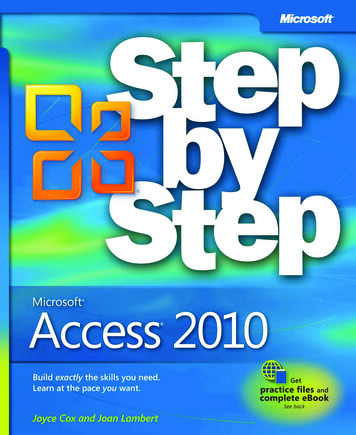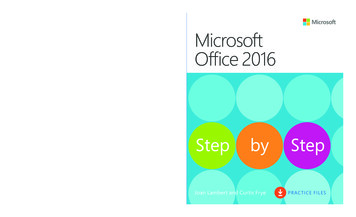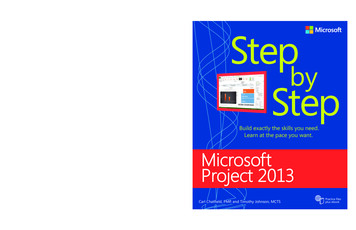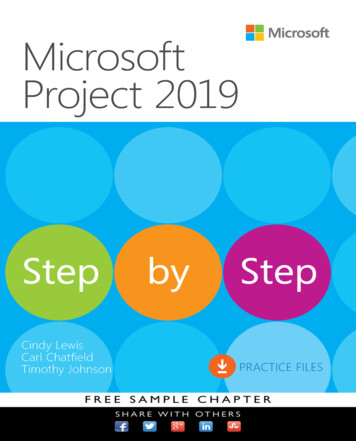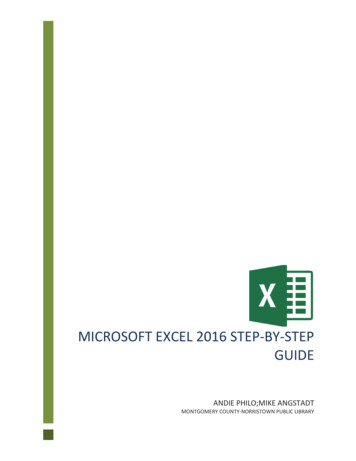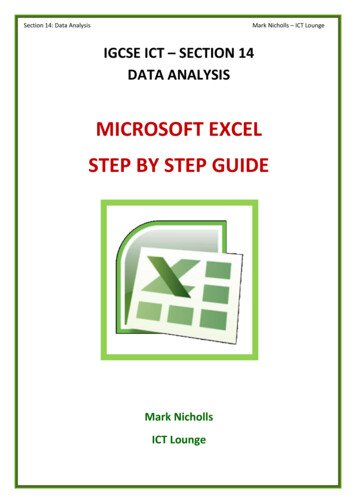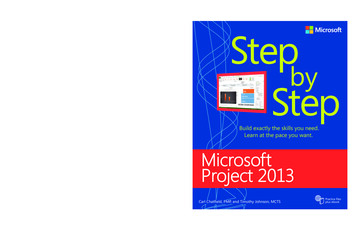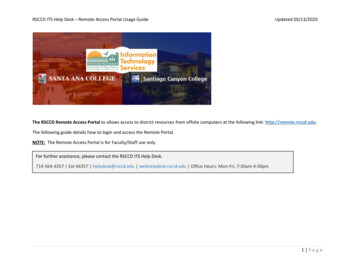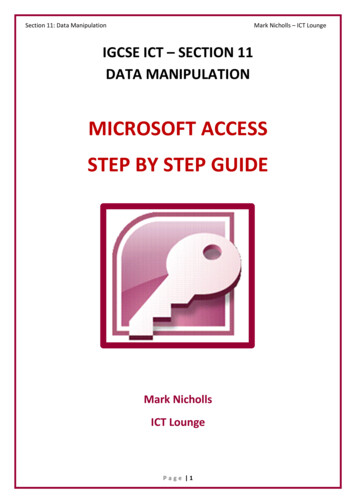
Transcription
Section 11: Data ManipulationMark Nicholls – ICT LoungeIGCSE ICT – SECTION 11DATA MANIPULATIONMICROSOFT ACCESSSTEP BY STEP GUIDEMark NichollsICT LoungePage 1
Section 11: Data ManipulationMark Nicholls – ICT LoungeContentsTask 35 details Page 3Opening a new Database . Page 4Importing .csv file into the Database . Page 5 - 9Amending Field Properties . Page 10 - 11Taking Screenshot Evidence Page 12Task 36 details . Page 13Inserting and Checking New Records . Page 13 - 14Task 38 details . Page 15Identifying Query Tasks and Report Tasks Page 15Creating the First Query . . Page 16 - 17Creating a Calculated Field within the Query Page 18 - 19Changing Format of a Calculated Field . Page 20First Query Search Criteria Page21 - 22Setting up a Report of the First Query . . Page23 - 27Performing Calculations within Reports . Page 28 - 31Adding Header and Footer information to a Report . Page 32 - 34Task 40 details . Page 35Creating the Second Query . Page 35 - 37Second Query Search Criteria . Page 37 - 39Setting up Labels of the Second Query Page 39 - 43Adding Header and Footer information to Labels Page 43 - 46Task 42 details Page 47Creating the Third Query . Page 47Third Query Search Criteria Page 47 – 48Hiding Fields within a Query . Page 48Sorting information within a Query Page 49Task 43 and 44 details . Page 51Exporting Data from a Query Page 51 – 53Importing Exported Data into a Word Document Page 52Extra Info --- Summarising Data . Page 54 - 56Page 2
Section 11: Data ManipulationMark Nicholls – ICT Lounge2010 Database Task – WalkthroughQ35 Using a suitable database package, import the file N10EKS.CSVAssign the following data types to the fields:MakeModelSizePriceSkill LevelWind ConditionUseNumberStock ItemTextTextNumeric/1 decimal placeCurrency/2 decimal ke sure that you use these field names. You may add another field as aprimary key field if your software requires this.Save a screen shot showing the field names and data types used. Print a copyof this screen shot.Make sure that your name, Centre number and candidate number areincluded on this printout.The solution to task 35 will be detailedover the pages 2 - 10.Page 3
Section 11: Data ManipulationMark Nicholls – ICT LoungeOpening a Database - How to do it:1. Open Microsoft Access by clicking: Start Button All Programs Microsoft Office Microsoft Access2. Click the Office Button followed by New to open the Blank Database pane on theright-hand side in the window.3. Enter a meaningful File Name: for the database.For example ‘Kites’ would make sense as this isthe type of information that the database willhold.4. Click on the Browse button (yellow folder) andchoose where you would like to save yourdatabase (Data Manipulation folder).Press5. Click on.and you will be presented with a new database similar to this:Page 4
Section 11: Data ManipulationMark Nicholls – ICT LoungeImporting the N10EKS - How to do it:1. Copy the 2010 Past Paper Walkthrough folder into your Data Manipulationfolder.2. SelecttheExternalImport Text File icon.DatatabthenclickontheIMPORTANT NOTE: Files saved in .csv format are considered text files. Each dataitem is separated from the next by a comma.3. This icon opens up the Get External Data window like this:Use thebutton to findthe file‘N10EKS.CSV’.NOTE: Ensure the top optionbutton is selected. This ensuresthe data is saved in a new table.Click on.IMPORTANT NOTE: A large number of students perform poorly in this section ofthe exam because they select the bottom option instead ofthe top one.Page 5
Section 11: Data ManipulationMark Nicholls – ICT Lounge4. The Import Text Wizard window willopen.5. Select the ‘Delimited’ option. Thisoption is for data that is separated by acomma (as is the case in .csv files)Click on.6. For the next part of the wizard make sure that the Comma option is selectedusing the option buttons.Examine the first row of the data anddecide if it contains the fieldnames thatyou need or if it contains the first row ofdata.7. If the first row contains thefieldnames, click on the First RowContains Field Names tick box. As youtick the box the first row changes fromthis to this.Page 6
Section 11: Data Manipulation8. Click ontoSpecification window.Mark Nicholls – ICT LoungeopentheImportCheck that all fieldnames and data types matchthose specified in task 35. In this case the Size, Priceand Stock Item fields are not correct. Make thefollowing changes:Size field needs changing to Long IntegerPrice field needs changing to CurrencyStock Item needs changing to Boolean (Yes/No)9. To make these changes, click on the Data Typecell for each of the fields and use the drop-downlist to select the correct options as described inthe list above.Your completed fields and data types list should look like the following screenshot.Page 7
Section 11: Data ManipulationMark Nicholls – ICT LoungeWhen all of the changes have been made, click on10.Select.twice.11.On the screen where Access is asking you about a Primary Key you should ensurethat you select the option ‘Let Access add primary key’.This adds a new field called ID to the table.NOTE: Primary Keys ensure that each record can be uniquely identified.12.Click on.13.In the Import to Table: boxenter ‘tblKites’.NOTE: This is a meaningful table name. The ‘tbl’ shows you that it is a table andthe ‘Kites’ gives an idea of what kind of data is being held.14.Click onto import the data and thenPage 8to close the wizard.
Section 11: Data ManipulationMark Nicholls – ICT Lounge15.Double click on tblKites to display the imported information which should looklike this:tblKites – containingthe imported .csv dataImportedrecordsPage 9
Section 11: Data ManipulationMark Nicholls – ICT LoungeAmending Field Properties – how to do it:1. Changes to the field types, or other properties, can be made from theHome tab. In the Views section, click on the Design View icon.2. The task instructed you to set theSize field to 1 decimal place. Youcan check this by clicking the leftmouse button in the Size field andviewingthenumberofDecimal Places in the General tabat the bottom of the window.As you can see this is not set to 1decimal place but set to ‘Auto’.3. Click on the cellcontaining ‘Auto’ and use thedrop-down list to set this to 1decimal place.Use the same method to setthe Price field (which iscurrency data type) to 2decimal places.P a g e 10
Section 11: Data ManipulationMark Nicholls – ICT Lounge4. To change the Boolean field so that itdisplays ‘Yes’ or ‘No’, click in the StockItem field and in the General tab selectthe Format cell.5. Use the drop-down list to select theYes/No option.6. Save the database for later use by clicking theP a g e 11symbol.
Section 11: Data ManipulationMark Nicholls – ICT LoungeTaking a screenshot – how to do it:1. Open your Kites Table in Design View.2. The task asks you to take a screenshot of the Field Names and Data Types usedwithin the table. To do this, simply press PrtScn onthe keyboard.3. Open up an empty Microsoft Word document andthen click Paste.4. Add your Name, Centre Number and Candidate Number to the Footer.Your finished screenshot should look something like this:5. Print a copy of your screenshot.P a g e 12
Section 11: Data ManipulationMark Nicholls – ICT LoungeQ36 Insert the following three records:MakeModelSizePriceSkill ghUseNumberKite SurfKite SurfKite Surf111Stock ItemYesYesYesCheck your data entry for errors.Q37 Save the data.Inserting new records - How to do it:1. Double click on tblKites to view the records.DatabaseRecordstblKites2. Scroll to the bottom of the table and look for the row which is marked with anasterix (*). The asterix indicates that this row is where new records are input.New records inserted here3. Enter the 3 new records as specified in task 36.P a g e 13
Section 11: Data ManipulationMark Nicholls – ICT LoungeChecking data entry - How to do it:All this requires you to do is to read through the new records that you have enteredand double check that they match those stated in task 36.It is vital that your data entry is EXACTLY the same as the information stated in thequestion or you will run into problems when you come to search the database laterin the exam.Remember task 36 required you to add the following records:MakeModelSizePriceSkill ghUseKite SurfKite SurfKite SurfNumber111Stock ItemYesYesYesSave the data – How to do it:To save the new records in the table simply press the Save button which you canfind to the right of the Office Button (top left of the screen).P a g e 14
Section 11: Data ManipulationMark Nicholls – ICT LoungeQ38 Produce a report which:1. Contains a new field called Order which is calculated at run-time. This fieldwill calculate the Price multiplied by 32. Has the Order field set as currency with 2 decimal places3. Shows only the records where Number is less than 2 and Stock item is Yes4. Shows all the fields and their labels in full5. Fits on a single page6. Has a page orientation of landscape7. Sorts the data into ascending order of Make (with Airush at the top)8. Calculate the total value of kites to be ordered and:o Shows this total value at the bottom of the Order columno Formats this total value to currency with no decimal placeso Has the label ‘Total order value’ for the total value9. Include the heading ‘Kites we need to restock’ at the top of the page10.Has your Name, Centre Number and Candidate Number on the left footerof each page.This task is the most difficult of them all. It requires you to produce a report.However before you can make the report you must create something called a query.What is a query?A query is a way to search through the data stored in the database to producemeaningful results.In this question the query needs to search the database in 2 ways:1. Search the information where Number is less than 2 AND Stock Item is ‘Yes’.2. Includes a field called ‘Order’ which is calculated at run-time and multipliesthe Price field by 3.What is a report?A report is a method we use to display our information in the clearest waypossible. Reports are essentially the output of the database.The report in this question only wants us to display information that meets certaincriteria and, therefore, we also need to create a query.P a g e 15
Section 11: Data ManipulationMark Nicholls – ICT LoungeNOTE: You MUST be able to determine the difference between a query and a reportin this task. In short: Any tasks which sound like you need to search for information are tackledwithin the query. Any tasks which sound like they are talking about the display of theinformation should be tackled within the report.Creating the query – How to do it:1. Click Create and then Query Wizard.2. Select Simple Query Wizard then click OK.3. On the next screen, you should make surethat tblKites option is selected. Use thearrows to move the fields from theAvailable Fields: window into theSelected Fields: window.SelectedFieldsArrowsAvailableFieldsP a g e 16
Section 11: Data ManipulationMark Nicholls – ICT Lounge4. Select the ‘Detail – show every field ofevery record’ option then press Next.(If the task required a summary of datathen you would choose ‘Summary’)5. Choose a name which suits the task. I suggest ‘Kites Order Query’.Select the ‘Modify the QueryDesign’ option. This lets uscreate our searches.Click Finish.This takes us to the Query Design screen and from here we can tell Access whichdata we would like to search for:Query DesignP a g e 17
Section 11: Data ManipulationMark Nicholls – ICT LoungeCreating the Calculated Field ‘Order’ – How to do it:The problem: Produce a report which:1. Contains a new field called Order which is calculated at run-time. This field willcalculate the Price multiplied by 3Calculated fields only work during run-time. This means that the calculation is madeas the query is activated or ran.NOTE: It is important to understand that Calculated fields are ALWAYS createdwithin queries nowhere else.1. In query design view find the Stock Item field.2. Click the mouse cursor into the empty field to the right of Stock Item.3. In the empty field type Order: [Price] * 3This creates a new field called ‘Order’.The Order field will store the result of the[Price] fieldmultiplied by 3.Breakdown of what is happening here:This tells Access what toname the new fieldThis tells Access whichmathematicalcalculation to useThis tells Access which currentfield to use in the calculationP a g e 18
Section 11: Data ManipulationMark Nicholls – ICT LoungeNOTE: It is essential that you follow the correct syntax. For example: Correct order Using a colon ( :) after the new field name Using square brackets [] to surround the current field’s name Using the correct mathematical symbol (see below)Mathematical symbols are as follows:*(multiply)/(divide)-(subtract) (add)4. Run the query by clicking the Datasheet View button.Your query result will be displayed with a calculated field called Order thatcontains the Price field multiplied by 3.Order field multiplies the contentsof the Price field and displaysP a g e 19
Section 11: Data ManipulationMark Nicholls – ICT LoungeSetting the ‘Order’ field to currency and 2 decimal places –How to do it:The Problem: Produce a report which:2. Has the Order field set as currency with 2 decimal places1. Open the Kites Order Query in DesignView. To do this, right click the query andthen select Design View.2. Highlight the Order field then right clickand select Properties.3. In the Properties Sheet change the Formatto Currency by using the drop-down list.4. Run the query in Datasheet View and checkto make sure that your Order field is set toCurrency.NOTE: Currency fields should be set to 2 decimal places by default.P a g e 20
Section 11: Data ManipulationMark Nicholls – ICT LoungeCreating some query search criteria – How to do it:The Problem: Produce a report which:3. Shows only the records where Number is less than 2 and Stock item is Yes1. Open the Kites Order Query in Design View.2. Click in the Criteria: section of Number field:3. As the question requires us to search for only the records where the number isless than 2 we need to type in 2Breakdown of what is happening here:This Operator Symbolstands for ‘less than’ 2This tells Access whichnumber to be less thanNOTE: Operator symbols in the green cells can only be used on Number Fields orCurrency Fields. Other operator symbols include: (More Than) (More than or equal to) (Equal To)LIKE * * (wordscontaining) (Less Than) (Less Than or Equal to)Between And (Between 4 And 8 for example)OR (Low OR Medium OR High for example)LIKE a* (starting with a) LIKE *a (ending with a)P a g e 21
Section 11: Data ManipulationMark Nicholls – ICT Lounge4. Click in the Criteria: section of the Stock Item field:5. The question wants us to search for records where Stock Item is ‘Yes’. To do thissimply type Yes into the criteria box.6. Run the query in Datasheet View and check to make sure that the database hasonly returned records that match our criteria (Number less than 2 and StockItem of Yes).All numbers are lessthan 2All stock itemsare YesNOTE: All records that do not match our criteria are omitted from the search resultP a g e 22
Section 11: Data ManipulationMark Nicholls – ICT LoungeCreating the report using the Kite Order Query – How to do it:The Problem: Produce a report which:4.5.6.7.Shows all the fields and their labels in fullFits on a single pageHas a page orientation of landscapeSorts the data into ascending order of Make (with Airush at the top)Once we have our completed query we can take this information and display it inthe form of a report.1. Click Create and then Report Wizard.2. On the next screen, you should make sure that Kites Order Query option isselected.SelectedFieldsAvailableFieldsUse the arrows to move the fields from the Available Fields: window into theSelected Fields: window.Press Next and the Next again.P a g e 23
Section 11: Data ManipulationMark Nicholls – ICT LoungeSorting data into ascending order of make:3. In the Sort Order section, use the drop-down box to select the Make Field.Make sure that it is set to Ascending(Low to High).Click Next.Landscape page orientation:4. Set the Page Orientation to Landscape(Wide) and leave Layout as Tabular.Click Next.5. Choose a Design for your report (I chose‘None’ option as it is easier to re-designlater)Click Next.P a g e 24
Section 11: Data ManipulationMark Nicholls – ICT Lounge6. Choose a report name which suits the task (I chose Kites Order Report).Select the ‘Modify the QueryDesign’ option. This lets uscustomise our report.Click Finish.Showing all fields and labels and making sure the report fits onto asingle page:1. You should be in Report Design View. It looks like this:Field LabelsSome labels/fields are notlarge enough to hold the dataFieldsClearly this report needs some work for the following reasons: It is messy The labels and fields are not large enough to display the information The report does not fit onto a page.If I ran this report in Report View you will see what I mean.P a g e 25
Section 11: Data ManipulationMark Nicholls – ICT LoungeReport View:Generally messySome labels/fields are notlarge enough to hold the dataResizing Fields2. Click the drop down arrow on the View option and select Design View.This lets us make the required changes.3. Click on the Make field and drag the handles out to create more spacefor the information.4. Click back on Report View to make sure that the field has been resized enough tohold all of the information. It looks okay.5. Continue doing this until all of the fields are just the right size to hold theinformation. You may need to reduce the size of some of them if they are toolarge.NOTE: Fields can also be resized to make them higher instead of wider. This isuseful to force longer pieces of data onto a new line and, therefore, take upless room widthways.P a g e 26
Section 11: Data ManipulationMark Nicholls – ICT LoungeFields all large enough to hold the informationAligning FieldsFields needs to be further apart1. ID, Model, Price and Skill Level fields could benefit from being further apart. Thiswill make them easier to read.2. Move the cursor into the Page Header section and click on the ID label.3. Centre the label using the CentreAlignment tool in the Design tab.4. Repeat this for the ID field in the Detail section.5. Use the same techniques to re-align the other problem areas in the report.Much neater layoutP a g e 27
Section 11: Data ManipulationMark Nicholls – ICT LoungeCalculating total value of kites on the report – How to do it:The Problem: Produce a report which:8. Calculate the total value of kites to be ordered and:o Shows this total at the bottom of the Order columno Formats this total value to currency with no decimal placeso Has the label ‘Total order value’ for the total value.To add a total to the report you will insert a text box into the Report Footer section.By default the Report Footer section is hidden from view and so you have to createsome room for the text box.Creating some room in the Report Footer.1. Position your cursor to the bottom of the Report Footer bar so that the cursorchanges to an arrow.2. Hold the left mouse button down and drag the Report Footer row down a littlebit to make some room.3. In the Design section click the Text Box option.P a g e 28
Section 11: Data ManipulationMark Nicholls – ICT LoungeCalculating the total value of the kites to be ordered.1. Draw the text box into the Report Footer underneath the Order field.2. In the Unbound text box type SUM([Order])This adds up all of the values stored inthe ‘Order’ field. SUM means ADD TOGETHER.Breakdown of what is happening here:This tells Access that we want toadd something (or total) SUM ([Order])This tells Access which fieldwe want to totalNOTE: It is essential that you follow the correct syntax. For example: Correct order Using an sign in front of the calculation Using the SUM function if the task requires you to total something Using curved AND square brackets ([]) to surround the field’s nameP a g e 29
Section 11: Data ManipulationMark Nicholls – ICT LoungeNOTE: In your exam you will be asked to use one of several possible types ofcalculation within your report:1. ([SUM])- Used if the question requires you to total a field2. ([COUNT])- Used if the question requires you to count the number of records in a field.3. ([AVG])- Used to calculate the average value of a field4. ([MAX])- Used to find the highest number within a field5. ([MIN])- Used to find the lowest number within a fieldFormatting the total value to currency with no decimal places.1. Make sure the report is open in Design View.2. Click the text box which contains the calculation.3. In the Design section click Property Sheet.4. The Property Sheet for the text box will open.You should make sure that you are in the ‘All’ section.5. Find the Format setting and use the drop-down box toselect Currency.6. Use the Decimal Places setting toselect 0.P a g e 30
Section 11: Data ManipulationMark Nicholls – ICT LoungeAdding the label ‘Total order value’.1. Close the Property Sheet and click in the label for your calculated field.2. Change the text to ‘Total order value’. (Resize or move label if necessary)3. Run the report in Report View and scroll to the bottom.Your calculated field and label should appear. Notice howthe Order Total has no decimal places:Total Value LabelP a g e 31Total Value Calculation(0 decimal places)
Section 11: Data ManipulationMark Nicholls – ICT LoungeChanging the Report Heading to ‘Kites we need to restock –How to do it:The Problem: Produce a report which:9. Includes the heading Kites we need to restock at the top of the page.1. Make sure the report is open in Design View.2. Move the cursor into the Report Header section.3. Click in the heading (label) we currently have and delete the contents.4. Type in the required text – ‘Kites we needto restock’.P a g e 32
Section 11: Data ManipulationMark Nicholls – ICT Lounge5. Check in Report View that the new heading is: At the top of the page The EXACT words given in the question Spelt correctly.It should look like this:Adding Name, Centre Number and Candidate Number – How todo it:The Problem: Produce a report which:10. Has your name, Centre Number and Candidate number on the left footer of eachpage.1. Make sure the report is open in Design View.2. Move the cursor into the Page Footer section.P a g e 33
Section 11: Data ManipulationMark Nicholls – ICT Lounge3. Delete the text box containing the formula Now()4. In the Design section click the Label tool.5. Drag your label out in the Page Footer where the Now() text box used to be.6. Type your name, Centre Number and Candidate number into the label.7. Use Report View and scroll to the bottom of the page to check that the requiredinformation is fully visible. It should look something like this:Save and Print this report.P a g e 34
Section 11: Data ManipulationMark Nicholls – ICT LoungeQ40 Produce labels from all the data which:1. Fit two side by side on the page2. Show only the records where Use field contains Kite Surf, the Stock itemfield is Yes and the Skill level is not Beginner3. Shows only the fields Make, Model, Size, Price and Wind Condition, eachon a separate line.4. Displays the field name as well as the data5. Are sorted into ascending order of Size6. Include the heading ‘Special offer for kite surfers’ at the top of each label7. Has your Name, Centre Number and Candidate Number at the bottom ofeach label.This task, again, requires you to produce a query that searches for the requiredrecords described in task 2 of Q39.The rest of Q39 can be tackled in the process of making the labels.Creating the query – How to do it:NOTE: The question clearly requires you to make the labels based on all the dataso you should ensure that the query is sourcing tblkites and not your Order query.1. Click Create and then Query Wizard.2. Select Simple Query Wizard then click OK.P a g e 35
Section 11: Data ManipulationMark Nicholls – ICT Lounge3. On the next screen, you should make surethat tblKites option is selected. Use thearrows to move the fields from theAvailable Fields: window into the SelectedFields: window.SelectedFieldsArrowsAvailableFields4. Select the ‘Detail – show every field ofevery record’ option then press Next.(If the task required a summary of datathen you would choose ‘Summary’)6. Choose a name which suits the task. Isuggest ‘Labels Query’.Select the ‘Modify the QueryDesign’ option. This lets us createour searches.Click Finish.P a g e 36
Section 11: Data ManipulationMark Nicholls – ICT LoungeThis takes us to the Query Design screen and from here we can tell Access whichdata we would like to search for:Query DesignSpecifying the query criteria – How to do it:The problem: Produce labels from all the data which:2. Show only the records where Use field contains Kite Surf, the Stock item field isYes and the Skill level is not BeginnerRecords containing the words Kite Surf1. Open the Labels Query in Design View.2. Click in the Criteria: section of the Use field.3. Type Like *Kite Surf* into the criteria field.NOTE: The ‘Like * *’ criteria tells Access that you are performing a wildcardsearch. Any record containing the words ‘Kite Surf’ will be returned.Wildcard searches should be used as the criteria for any search questions that askyou to find records that contain specific words.P a g e 37
Section 11: Data ManipulationMark Nicholls – ICT LoungeRecords where Stock Item field is Yes1. In the Labels Query click in the Criteria: section of the Stock Item field.2. Type Yes into the Stock Item criteria field.Records where Skill Level Item field is Not Beginner1. In the Labels Query click in the Criteria: section of the Skill Level field.2. Type Not “Beginner” into the Skill Level criteria field.NOTE: The Not “ “ criteria tell Access that you are looking for every other recordapart from the word included within the Not “ “ criteria.In this example there were 3 types of record held in the Skill Level field: Beginner Intermediate ExperiencedIncluding ‘Beginner’ within the Not criteria excludes it from the search and Accesswill only look for records containing ‘Intermediate’ and ‘Experienced’.P a g e 38
Section 11: Data ManipulationMark Nicholls – ICT Lounge3. Run the query by clicking the Datasheet View button.Access will now search for the records that match all 3 of the search criteria that wehave created. Your results should look like this:Skill Level field does notcontain ‘Beginner’Use field contains thewords ‘Kite Surf’Stock Item YesCreating the Labels – How to do it:The problem: Produce labels from all the data which:1. Fit two side by side on the page3. Shows only the fields Make, Model, Size, Price and Wind Condition, each on aseparate line.4. Displays the field name as well as the data5. Are sorted into ascending order of SizeLabels are a special kind of report. They are designed to provide a short, summary ofinformation and you are usually required to fit two labels side by side.P a g e 39
Section 11: Data ManipulationMark Nicholls – ICT LoungeFirst steps in creating labels1. Click on the Labels Query without opening it.2. Click Create and then Labels.Fitting 2 labels side by side1.The task asks you to fit two labelsside by side so select an option wherethe ‘number across’ is 2.Label Type option should be ‘SheetFeed’.Click Next.2. The next screen allows you choose font styles and sizes but the task does notspecify any formatting so it would be advisable to leave this alone.Click Next.P a g e 40
Section 11: Data ManipulationMark Nicholls – ICT LoungeShowing the correct fields and field namesTasks 3 and 4 require you to do 2 things: Only show the fields Make, Model, Size, Price and Wind Condition each on aseparate line Show the field names as well as the actual data.1. Type the field name ‘Make’ into the Prototype Label window (with a space atthe end of the letter ‘e’).Space after the letter ‘e’2. Click on the Make field and use the arrow to move it into the label.Make field inserted into the labelafter the field name we added3. Press enter to move the cursor to the line below.P a g e 41
Section 11: Data ManipulationMark Nicholls – ICT Lounge4. Add the other necessary fields and field names in the same way (Model, Size,Price, Wind Condition).Yourlabelwindowshould look like this:Click NextSeparate LinesSorting Size field into ascending orderTask 5 needs you to sort the Size field into Ascending Order. Ascending means‘From low to high’.This means that the data will be sorted from the lowest kite size to the highest.NOTE: Descending Order is the opposite – From high to low.1. Click on the Size field and use the single arrow to move it into the Sort By:window.By default, Acc
Open Microsoft Access by clicking: Start Button All Programs Microsoft Office Microsoft Access 2. Click the Office Button followed by New to open the Blank Database pane on the right-hand side in the window. 3. Enter a meaningful File Name: for the
